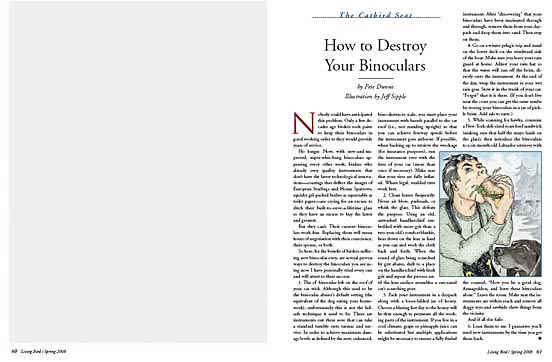The Catbird Seat: How to Destroy Your Binoculars
By Pete Dunne April 15, 2008
Nobody could have anticipated this problem. Only a few decades ago birders took pains to keep their binoculars in good working order so they would provide years of service.
No longer. Now, with new-and-improved, super-whiz-bang binoculars appearing every other week, birders who already own quality instruments that don’t have the latest technological innovations – coatings that deflect the images of European Starlings and House Sparrows; squishy gel-packed bodies as squeezable as toilet paper – are crying for an excuse to ditch their built-to-serve-a-lifetime glass so they have an excuse to buy the latest and greatest.
But they can’t. Their current binoculars work fine. Replacing them will mean hours of negotiation with their conscience, their spouse, or both.
So here, for the benefit of birders suffering new binocular envy, are several proven ways to destroy the binoculars you are using now. I have personally tried every one and will attest to their success.
1. The ol’ binocular left on the roof of your car trick. Although this used to be the binocular abuser’s default setting (the equivalent of the dog eating your homework), unfortunately this is not the fail-safe technique it used to be. There are instruments out there now that can take a standard tumble onto tarmac and survive. In order to achieve maximum damage levels as defined by the new, enhanced, bino-destructo scale, you must place your instrument with barrels parallel to the car roof (i.e., not standing upright) so that you can achieve freeway speeds before the instrument goes airborne. If possible, when backing up to retrieve the wreckage (for insurance purposes), run the instrument over with the tires of your car (more than once if necessary). Make sure that your tires are fully inflated. Where legal, studded tires work best.
2. Clean lenses frequently. Never air blow, prebrush, or whisk the glass. This defeats the purpose. Using an old, unwashed handkerchief embedded with more grit than a two-year-old’s comfort blankie, bear down on the lens as hard as you can and work the cloth back and forth. When the sound of glass being scratched by grit abates, shift to a place on the handkerchief with fresh grit and repeat the process until the lens surface resembles a one-eared cat’s scratching post.
3. Pack your instrument in a daypack along with a loose-lidded jar of honey. Choose a blazing hot day so the honey will be thin enough to permeate all the working parts of the instrument. If you live in a cool climate, grape or pineapple juice can be substituted but multiple applications might be necessary to ensure a fully fouled instrument. After “discovering” that your binoculars have been marinated through and through, remove them from your daypack and drop them into sand. Then step on them.
4. Go on a winter pelagic trip and stand on the lower deck on the windward side of the boat. Make sure you leave your rain guard at home. Adjust your rain hat so that the water will run off the brim, directly onto the instrument. At the end of the day, wrap the instrument in your wet rain gear. Stow it in the trunk of your car. “Forget” that it is there. (If you don’t live near the coast you can get the same results by storing your binoculars in a jar of pickle brine. Add salt to taste.)
5. While scanning for hawks, consume a New-York-deli-sized roast beef sandwich (making sure that half the mayo lands on the glass), then introduce the binoculars to a six-month-old Labrador retriever with the counsel, “Now you be a good dog, Armageddon, and leave these binoculars alone.” Leave the room. Make sure the instruments are within reach and remove all doggy toys and rawhide chew things from the vicinity.
And if all else fails:
6. Loan them to me. I guarantee you’ll need new instruments by the time you get them back.

All About Birds
is a free resource
Available for everyone,
funded by donors like you
American Kestrel by Blair Dudeck / Macaulay Library



